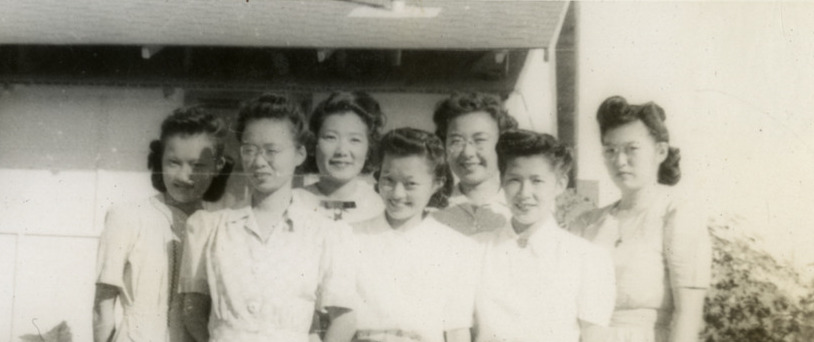March 14, 2022
Brynn Saito is a Korean American and Japanese American poet, educator, and organizer, born and raised in Fresno, California. In response to our Women’s History Month call for writers to respond to photos of women in Densho’s archives or their own collections, Brynn reflects on the stories told and untold within the archives asks “what exists outside the frame,” and follows “the bright red threads” of those unanswered questions into the future.
What Exists Outside the Frame

Seven young Japanese American women staggered evenly, and an eighth—Tazu Kawamoto—kneeling in the front. Sun-bright faces, bodies framed by desert foliage. Behind them, a barrack? Bathhouse or some other camp structure? I find the image when searching for my grandmother’s face in Densho’s Gila River archive of stills. No family camp-era photos from the Saitos or Teranishis, forced from their homes in California’s Central Valley and incarcerated at Gila River. A story or two, a spoken image—Grandpa recalling his time in the Military Intelligence Services, Grandma fuming while describing the packed, hot train ride to camp—delivered to my young brain and barely processed before they died young. Heart failure, heart attacks, strokes.
Decades later, I scour the archives, unknowingly propelled by a desire to stumble across my grandmother’s face, my grandfather going out for a smoke. I find Tazu Kawamoto instead, and the “Kawamoto (Tazu) Photo Album Collection,” and the women in the sunlight, flashes of joy and squinted exhaustion across their faces. Standing neat, smiling. Together. Hair curled and styled just like hers. Was she near?
This is not my family. And yet. The archive opens a portal, reminds me that memory and imagination are of the same cloth. The archive and its shadow—what wasn’t recorded—gets me closer. To what? To the life there, a feel for it. And the feeling fills the silence. But what exists outside the frame? I look for her and I look for her. This desirous seeking—alive, unquenchable—connects me to others who carry a severing, who return to the archive as divinatory practice and communion. All the questions I have—for the ghosts, for the ancestors—root me to the earth, reveal my desire’s bright red threads. I follow those into the future.
—
Brynn Saito, MA, MFA, is the author of two books of poetry, Power Made Us Swoon (2016) and The Palace of Contemplating Departure (2013), winner of the Benjamin Saltman Award from Red Hen Press and a finalist for the Northern California Book Award. She’s the curator of an online project and chapbook, Dear—, and she co-authored, with Traci Brimhall, the poetry chapbooks, Bright Power, Dark Peace (Diode Editions, 2016) and Wild Recovery, published in Four Quartets: Poetry in the Pandemic(Tupelo Press, 2020). Brynn is an assistant professor of Creative Writing in the English Department at California State University, Fresno.
Read the rest of this series:
Nikiko Masumoto, “How to Wonder”
Karen L. Ishizuka, “Why, Oh Archive?”

